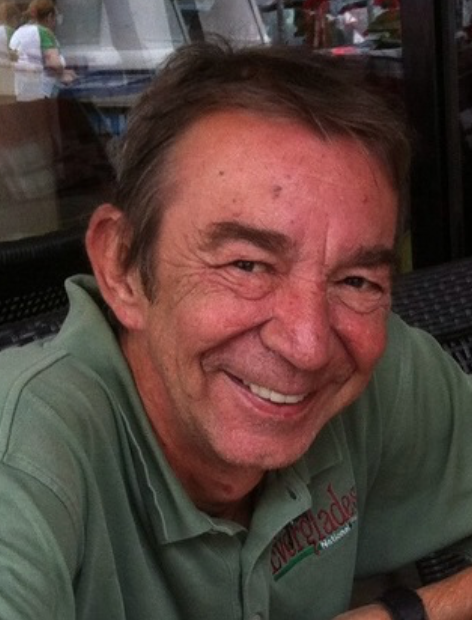
Thank you all for being here at this Memorial Service for Armin. Especially those who have travelled a long way to pay their respects to him. After the service, the Fuchs family would like to invite you for a bite to eat at Tim Finnegans, one of Armin’s favorite spots as you know, located just up the road.
My dear friend Armin Fuchs passed away early on Saturday morning last. He had just celebrated his 60th birthday on March 13. He was a great ping pong player and he took up golf when my father James came to Florida in the winter. (I even found a letter in my father’s effects from Armin to Jimmy circa 1993 relaying his progress in the grand old game). Armin’s handwriting is beautiful. When he wrote down equations they too were beautiful. Armin was a brilliant physicist who made our research sing. Brain and movement were his thing.
I first met Armin in the mid 1980’s when he was a computer geek in Hermann Haken’s Institute in Stuttgart under the supervision of a guy called Herbert Ono. I would often find him in the Café Zimmer behind a big pile of computer printouts. That’s where most of the science was done. The programming language for computer simulations of how lasers and fluids behave was Fortran. Which version of Fortran I don’t remember. A few years later I seduced him to come to FAU—first as a postdoctoral student for 3 years and then after a hiatus of a year or so as an assistant professor. He rose eventually to Full Professor of Complex Systems and Brain Science and Physics at our University.
The Bible says by your fruits ye shall be known. What are the highlights of Armin’s work? How can you get a computer to recognize an object when it is rotated or translated from one place to another? This is called the invariance problem in the field of perception and pattern recognition, and Armin solved it with The Synergetic computer. That was Armin’s Doctoral thesis.
When he first came to FAU he got involved in MEG--Magnetoencephalography—the spatiotemporal analysis of large SQUID arrays. Not calamari! Superconducting Quantum Interference Devices that pick up minute electric currents flowing in the human brain. This work made it into Nature magazine—with Armin’s graphics on the cover, pretty much a first for FAU. His great gift in computational analysis of large data sets and their visualization was complemented by brilliant theoretical modeling—extending the HKB model in multiple ways--for multilimb coordination, symmetry breaking, trajectory formation, and so forth--connecting the dynamics of the brain to what people do—how they move around and coordinate with the environment. Then Armin assembled the full armamentarium of brain imaging methods available at University MRI when we began to study concussion in football players. He demonstrated defects in white matter integrity in football players after a single concussion. When FAU first started their football program, the idea was to get the players’ brains imaged before the season started so that if they did get a concussion we could compare them to themselves. Armin realized this vision of personalized brain imaging long before it became popular.
The loss of Armin, to me, is like the loss of my right arm. Even worse. Armin and I communicated in the same language. He brought me down to earth at the same time as helping me realize new ideas—like most recently his model of the baby kicking the mobile to make the world change which explains the origins of agency; and the Dance project with Makaila Wallace the famous ballerina. How does Emotion get into physical movement? How does coherent dance emerge from a 96-dimensional space? It’s a miracle, but it does. And Armin showed how. It is very beautiful work, published just last year.
Of course, the work won’t end with Armin’s passing. But the unique leaps forward that he made will. Armin embraced the science of coordination. He helped formulate what the great physicist Erwin Schrodinger called “new laws for the organism”. For us humans that is. How we move and how we think and how our brains work dynamically, in real-time. Armin was a determined man. He did not give up. In science or with this damned cancer business or with anything. He was not religious but I thank the Lord of Love for him—as a scientist, a friend and as a human being who never let me down, who I could count on without fail.
In science, as in life, half the battle is asking the right questions. The fact of death, which is with us every moment of every day, causes us to ask big questions: who are we? What is it that dies? Does a person live after death or does he not? Armin taught and helped many students obtain their doctoral degrees and go on to do great things. At their Thesis defense, we had a tradition—just like the tradition of Friday Afternoon Drinking Club now called Beermail. That tradition included the recitation of a poem. So I leave you with some words of Wallace Stevens from his poem called “Sunday Morning”:
Death is the mother of beauty: hence from her
Alone, shall come fulfillment to our dreams
And our desires.
Armin Fuchs was a beautiful man. He was especially beautiful when he was in
love. I saw that once—or twice. Love transformed him.
What you see in this urn is not really what remains of Armin Fuchs.
Armin was a pure soul. We who knew him and loved him will always have
him in our hearts and heads.
Now death has stolen him away from us. We are not likely to meet the likes of him again in our lifetimes.
Teacher